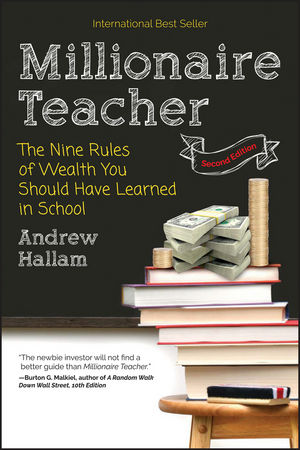From electric cars to re-usable rockets, new innovations and unanticipated breakthroughs can completely alter how we think about the future. With the exception a fine wine or smelly cheese, there aren’t many things that age well over time.
The same can be said about financial advice. The Fintech revolution, along with tools made available in recent years, has shifted the financial landscape. The new rules are slowly starting to change the way we think about money. Advice that made sense a few years ago also needs to evolve to keep up with the times.
Enter Millionaire Teacher: The Nine Rules of Wealth You Should Have Learned in School, by Andrew Hallam. Hallam- a high school English teacher working overseas – retired a millionaire in his 30s without the help of a defined benefit pension. Originally published in 2011, Millionaire Teacher demonstrated how average individuals like himself could build wealth in the stock market while avoiding the damage inflicted by the self-serving financial industry.
What’s changed?
The first edition of Millionaire Teacher, explained how the stock and bond markets work, how to build a portfolio of low cost index funds, and how to avoid the psychological behaviors that plague investors. Hallam takes everything that was good about the first and modernizes it with the improvements we’ve seen over the last several years.
In the second edition, Hallam takes great care in updating the evidence backing the advantages of index investing, including a shout out to a favorite- William Bernstein’s If You Can: How Millennials Can Get Rich Slowly.
Hallam highlights new cheaper products that can be used to build diversified portfolios, provides step by step instructions on how to buy ETFs and breaks down the benefits of robo-advisors for new and curious investors alike. Arguably the most valuable tidbits peppered throughout the book are the real life examples of how people in all walks of life practically apply the index investing approach.
Millionaire Teacher: Second Edition Review
Here are the nine rules that you should have learned in school.
 Rule #1: Spend Like You Want to Grow Rich – Spend like an actual rich person, not just a person that appears to be rich. While it might seem counterintuitive, rich people spend less on cars and homes. The more you save on unnecessary expenses, the more you can invest in wealth-building assets.
Rule #1: Spend Like You Want to Grow Rich – Spend like an actual rich person, not just a person that appears to be rich. While it might seem counterintuitive, rich people spend less on cars and homes. The more you save on unnecessary expenses, the more you can invest in wealth-building assets.
“Many have jeopardized their own pursuit of wealth or financial independence for the allusion of looking wealthy instead of being wealthy.”
Rule #2: Use the Greatest Investment Ally You Have – Start early, save often and invest to take advantage of the magic of compound interest– except if you have credit card debt.
“You can invest half of what your neighbors invest over your lifetime and still end up with twice as much money-if you start early enough.”
Rule #3: Small Fees Pack Big Punches – Financial advisors make money in fees and commissions at your expense when you buy actively managed mutual funds. Mutual fund returns are impacted by these fees and rarely stack up to index fund returns. Says who? Five Nobel Prize winners in Economics. That’s who.
“Index fund investing will provide the highest statistical chance of success, compared with actively managed mutual fund investing.”
Rule #4: Conquer the Enemy in the Mirror – The market is unpredictable. Trying to time investments is gambling. Invest regularly regardless of market conditions. If you have a long investment horizon, the best time to invest is when the market is falling.
“Most young people want their investments to rise right away…Instead, they should hope for stocks to sag or limp…They get less for their money when prices rise quickly.”
Rule #5: Build Mountains of Money with a Respectable Portfolio – A balanced portfolio is built from a combination of stocks and bonds. Known as asset allocation, the right combination of both provides stability by reducing the impact of sharp declines in the market.
“Only an irresponsible portfolio would fall 50% if the stock market value were cut in half. That’s because bonds become parachutes when stock markets fall.”
Rule #6: Sample a “Round-the-World” Ticket to Indexing – Investing in indexes isn’t has hard as it sounds. With practical examples on how to get started, this guide breaks down indexing in the United States, Canada, Great Britain, Australia and Singapore.
“Going solo is the cheapest (and potentially most profitable) way to invest in index funds.”
Rule #7: No, You Don’t Have to Invest on Your Own – While the plan is to invest across stock and bond indexes, ignore financial news and rebalance once a year might sound simple, it can be more difficult in practice. If you don’t trust yourself to stick to the plan, take yourself out of the equation. Intelligent investment firms (aka robo-advisers) can build and manage index fund portfolios for a low fee.
“Traditional investment firms…are like horse-drawn buggies. Intelligent investment firms…are Teslas. No matter how you slice it, they perform much better and they cost a lot less.”
Rule #8: Peek Inside a Pilferer’s Playbook – Financial advisers do not want you to invest in index funds- they don’t make any money off fees when you do. They’ve devised strategies to talk you into staying invested in actively managed mutual funds. If you know what they’re going to say, you have a better chance of removing the tick.
“Many financial advisers have mental playbooks…designed to deter would be-index investors. Many of their clients are forced to keep climbing mountains with 100-pound backpacks.”
Rule #9: Avoid Seduction – Crafty marketers will try to seduce you with get rich quick schemes. Whether they’re trying to sell investment advice or offer a once in a lifetime opportunity, the easy money is probably too good to be true. Steer clear of alternative investments to keep more of your hard-earned savings.
“At some point in your life, someone is going to make you a lucrative promise. Give it a miss. In all likelihood, it’s going to cause nothing but headaches.
The Last Word
While market conditions and investment tools have evolved, Hallam’s second pass at Millionaire Teacher reveals that the principles and application of low cost, diversified index fund portfolios remain steadfast.
The second edition of Millionaire Teacher is an excellent crash course in personal finance and investing. If you’re looking for a place to start and are curious of how regular people can become millionaires, look no further. The lessons you learn from this millionaire teacher will be sure to keep you aging well into the golden years.







